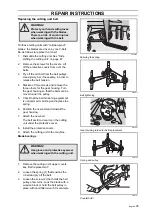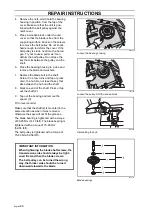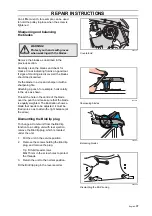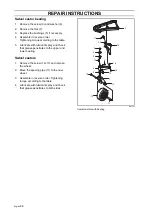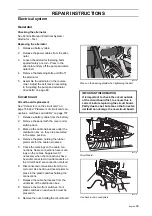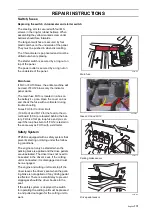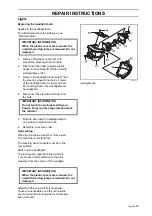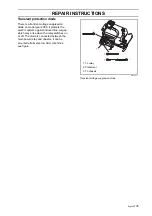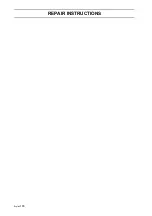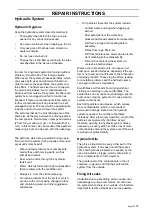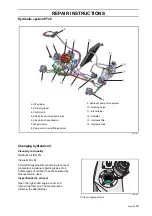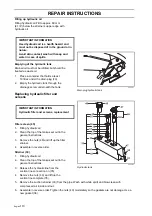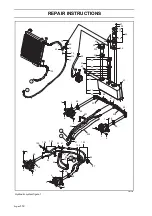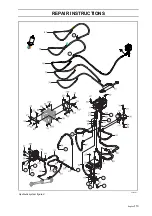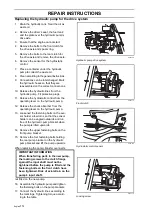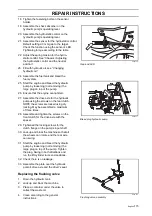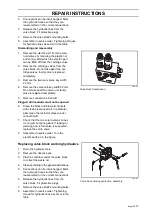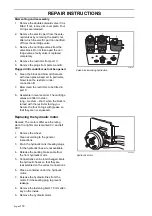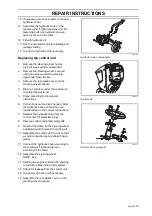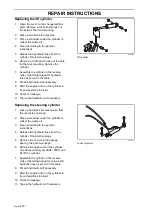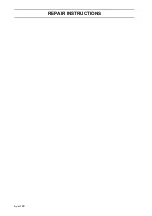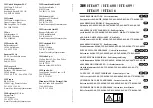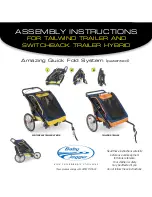
English-
107
REPAIR INSTRUCTIONS
Hydraulic System
Hydraulic Hygiene
Keep the hydraulic system clean. Remember to:
•
Thoroughly clean before the top-up cap is
opened or any connector loosened.
•
Use clean containers when topping up the oil.
•
Only use pure oil that has been stored in a
sealed container.
•
Do not reuse drained oil.
•
Change the oil and filter according to the inter-
vals specified in the Service Schedule.
In order for a hydraulic system to function without
problem, it must be free from foreign objects.
When used, the system produces particles, which
can cause both wear and abnormal function. In
order to remove these particles, the system con-
tains filters. The filters are sized so as to capture
the produced particles, but if contaminants are
introduced from outside the system, the filters can
quickly become clogged and fail to function as
intended. If there are contaminants in the system,
further contamination will be produced in a self-
propagating cycle. The result will be operating dis-
ruptions and much work to clean the system.
The particles that do the most damage are of the
same size as the play between the moving parts in
the components. Normal play in pumps and valves
is from 3-5 µm and up (1 µm = a thousandth of a
mm). In this context, we can mention that a particle
measuring 40 µm can be seen with the naked eye.
The particles, which are generated during opera-
tion or enter the system during repairs and service,
are usually comprised of:
•
Wear and tear products from components,
mainly those with moving parts, such as
pumps and motors.
•
Dust, which enters through the hydraulic
tank’s vent.
•
Water, which is formed through condensation.
(Steam enters with the ventilation air.)
•
Sludge etc. from the oil decomposing.
•
Corrosion products from the system, which
are due to the oil not being changed in time
and containing water and other aggressive
substances.
•
Dirt particles that enter the system include:
- Contaminants entering when topping up
with oil.
- Dust particles from the workshop.
- Gasket and thread sealants from assembly.
- Dirt from storage and handling before
assembly.
- Fibres from rags, filters, etc.
- Dirt from maintenance areas due to insuffi-
cient cleaning before disassembly.
- Dirt and dust entering the system via
unclean protective plugs.
Water, even in small amounts, can cause rust
build-up on sanded surfaces, especially if the sys-
tem is not used, and contributes to the production
of sludge products. These clog the filters, leading
to circulation problems and the hydraulic pump
can begin to draw air (cavitation).
Small fibres and threads from drying cloths or
clothing can build up in jets and throttles. The
actual fibres do not cause much damage, but the
build-up can clog the system and cause wear on
system components.
Each dirt particle is an abrasive, which causes
more contamination, which in turn leads to
permanent damage. Each time the hydraulic
system is opened, the number of particles
increases. After a few hours operation, most of the
particles are captured by the filters. Avoid,
therefore, opening the hydraulic system unless
necessary, as every action entails a risk of more
contaminants entering the system, even if the work
is carried out professionally.
Hydraulic Oils
The oil is as important as every other part of the
hydraulic system. It has been noted that about
70% of all hydraulic problems are caused by the
use of unsuitable oil types, which contain dirt or
other contaminants, to fill the system.
The greater part of the contaminants in the oil
comprise, in general, dirt that has entered the
system from the outside.
Fixing Oil Leaks
Cavitation due to penetrating air can cause inter-
nal damage to pumps and motors. Air can enter
the system when there is an oil leak. It is therefore
important to rectify oil leaks as soon as possible.
Summary of Contents for PT 26D
Page 1: ...Workshop manual PT26D English ...
Page 13: ...English 12 SPECIAL TOOLS ...
Page 94: ...English 93 REPAIR INSTRUCTIONS 8043 197 Cutting unit Combi 155 ...
Page 107: ...English 106 REPAIR INSTRUCTIONS ...
Page 123: ...English 122 REPAIR INSTRUCTIONS ...
Page 145: ......
Page 146: ...English 145 APPENDIXES Circuit diagram Circuit diagram 1 ...
Page 147: ...English 146 APPENDIXES Circuit diagram 2 ...
Page 148: ...English 147 APPENDIXES Circuit diagram 3 ...
Page 149: ...English 148 APPENDIXES Circuit diagram 4 ...
Page 150: ...English 149 APPENDIXES Circuit diagram 5 ...
Page 151: ...English 150 APPENDIXES Circuit diagram 6 ...
Page 152: ...English 151 APPENDIXES Circuit diagram 7 ...
Page 153: ...English 152 APPENDIXES Circuit diagram 8 ...
Page 154: ...English 153 APPENDIXES Circuit diagram 9 ...
Page 155: ...English 154 APPENDIXES Circuit diagram 10 ...
Page 156: ...English 155 APPENDIXES Circuit diagram 11 ...
Page 157: ...English 156 APPENDIXES ...
Page 161: ...English 160 APPENDIXES 8043 160 Circuit board placement ...
Page 162: ...English 161 APPENDIXES Hydraulic diagram 8043 247 Hydraulic diagram ...
Page 163: ...English 162 APPENDIXES ...
Page 167: ...2009W18 115 08 30 26 ...



